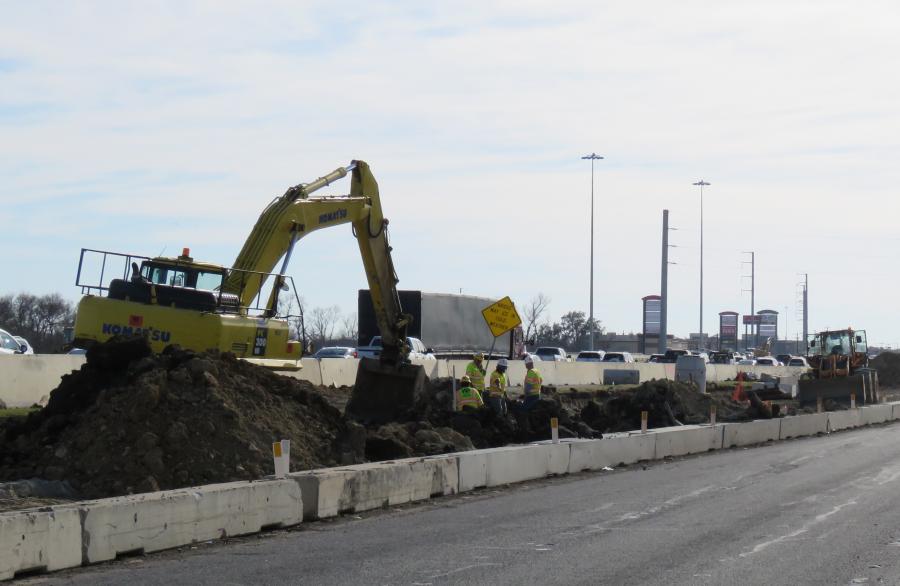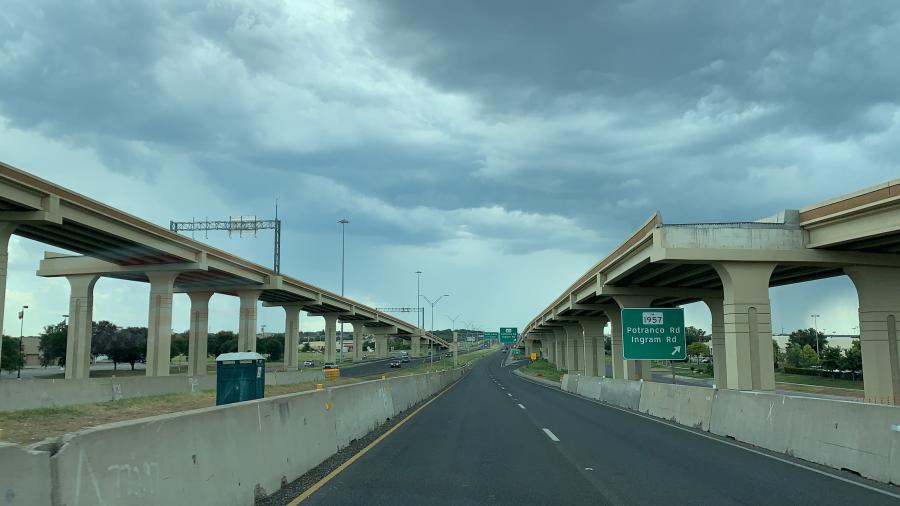Progress is being made on the two flyover ramps – one lane and approximately 3,500 ft. long — with both flyovers on schedule for completion in 2021.
Phase 1 of the I-410 Southwest improvement project in San Antonio, being constructed by Williams Brothers Construction Co. Inc. (WBC), began in fall 2019 and is expected to be delivered by 2022, with the direct connectors to be ready in 2021.
The $78 million contract involves adding one lane in each direction from U.S. 90 to Ingram Road (6.3 mi.), which is currently three lanes in each direction, and constructing two flyover ramps at the SH 151 interchange. The work also includes the installation of drainage infrastructure and electrical systems — signal and intelligent transportation systems (ITS).
The new asphalt lanes will increase vehicle capacity and improve traffic flow.
"Phase I was designed to reduce congestion and enhance safety for the over 400,000 drivers that travel the corridor each day," said Jennifer Serold, a TxDOT public information officer, San Antonio District. "These improvements will also improve mobility and connectivity as we prepare for future growth in the region."
The new lanes will be open to traffic prior to the construction of phases 2 and 3.
Phase 1 was designed in-house by TxDOT.
The project is on schedule and 45 percent of work has been completed. So far, WBC has completed the following elements: 50 percent of the substructures, portions of the drainage system, installation of steel girders and beams for both direct connectors. Efforts are now focusing on starting bridge deck construction (which started at the beginning of November) on northbound to westbound direct connectors, and continuing with the electrical work.
At this point, work is focusing in the bridges. The construction of the lanes is at an initial phase.
"The work continues to progress on schedule," said Serold. "Construction is being done at night at multiple sites, with minimal day work."
WBC has a fair amount of space at various sites to complete its work that are not impacted by traffic. Where the operations intersect with traffic, K rail separates crews from the dangers.
Good progress is being made on the two flyover ramps — one lane and approximately 3,500 ft. long — with the both flyovers on schedule for completion in 2021. WBC has been able to use TxDOT right-of-way to store materials, including pre-cast concrete beams, prior to installation.
Cranes have been essential pieces of equipment for the flyover construction, helping to lift and place many large pieces of concrete such as precast piers and beams of various sizes, as well as large and heavy pieces of steel. At several locations, four or five cranes are working in tandem. Also playing a key role on road operations are excavators, including Cat 325 and other large models, with various attachments for earth work and excavation and demolition activities.
The new lanes will be asphalt-based. The work started on the northbound side in terms of the phasing. Road construction crews will follow the earth work crews, with the excavated material to be taken to recycling centers.
Equipment with GPS systems is being used to help meet grade specifications for the road work.
The new lanes are based on 6-in. flex base, 9-in. TY B hotmix, 2-in. TY C hotmix, 1-in. thin overlay mix; a 10-in. TY B hotmix, 1-in. Thin Overlay mix, a 9-in. TY B hotmix, 2-in. superpave hotmix, a 5.5-in. TY B hotmix and 2-in. superpave hotmix.
With the road work areas completely separated from traffic, WBC is able to conduct operations on sections that are three lanes wide, which allows for construction vehicles to enter and exit the work zones easily.
Drainage infrastructure installation is on schedule.
Peak days have 30 plus WBC and subcontractor personnel on-site, with the general contractor hiring local and regional firms to assist with the work.
At this point, 38,000 cu. yds. of earth has been removed. New materials should include one million lbs. of steel; 128,000 tons of asphalt; 250,000 sq. ft. of concrete paving; 22,000 cu. yds. of concrete for bridge substructure and miscellaneous; and 9,900 linear ft. of drill shafts ranging from 12- to 120-in. diameter.
Other equipment being used by WBC includes: dozers, loaders, roller, pavers, water trucks, pickup trucks of various sizes and other essential equipment.
WBC purchases and rents equipment from local and regional dealerships.
The traffic management plan is based on temporary lane closures and detours, such as the full closure of SH 151 mainlanes from just west of I-410 to just east of I-410 and the full closure of SH 151 eastbound to westbound turnaround overnight closures for the construction of flyover ramps and installation of steel beams at the SH 151 and I-410 interchange.
Serold noted that the majority of closures occur at nights and on weekends, with minimal work being done during the day.
"Safety is our top priority at TxDOT," she said. "We are committed to work zone safety awareness and encourage drivers to move over, slow down and pay attention when traveling through areas of construction." CEG
Irwin Rapoport
A journalist who started his career at a weekly community newspaper, Irwin Rapoport has written about construction and architecture for more than 15 years, as well as a variety of other subjects, such as recycling, environmental issues, business supply chains, property development, pulp and paper, agriculture, solar power and energy, and education. Getting the story right and illustrating the hard work and professionalism that goes into completing road, bridge, and building projects is important to him. A key element of his construction articles is to provide readers with an opportunity to see how general contractors and departments of transportation complete their projects and address challenges so that lessons learned can be shared with a wider audience.
Rapoport has a BA in History and a Minor in Political Science from Concordia University. His hobbies include hiking, birding, cycling, reading, going to concerts and plays, hanging out with friends and family, and architecture. He is keen to one day write an MA thesis on military and economic planning by the Great Powers prior to the start of the First World War.
Read more from Irwin Rapoport here.
Today's top stories






















